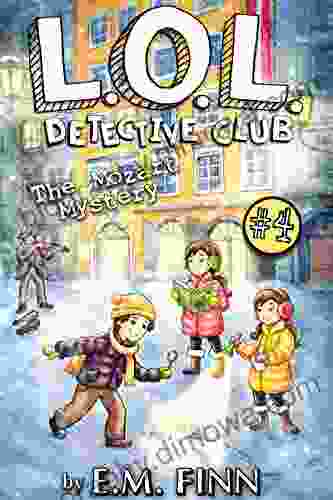Chemical Structure Spatial Arrangement: The Key to Understanding Chemical Behavior

5 out of 5
| Language | : | English |
| File size | : | 7129 KB |
| Text-to-Speech | : | Enabled |
| Screen Reader | : | Supported |
| Enhanced typesetting | : | Enabled |
| Print length | : | 423 pages |
| Hardcover | : | 552 pages |
| Item Weight | : | 2.8 pounds |
| Dimensions | : | 7 x 1.25 x 10.5 inches |
The three-dimensional structure of molecules is a fundamental aspect of chemistry. It determines the physical and chemical properties of molecules, and it is essential for understanding their behavior in chemical reactions. In this book, we will explore the various types of chemical bonds, the factors that determine molecular shape, and the relationship between molecular structure and chemical behavior.
Chemical Bonding
Chemical bonding is the process by which atoms are joined together to form molecules. There are three main types of chemical bonds: covalent bonds, ionic bonds, and metallic bonds.
Covalent bonds are formed when two atoms share one or more pairs of electrons. The strength of a covalent bond depends on the number of shared electrons. The more shared electrons, the stronger the bond.
Ionic bonds are formed when one atom transfers one or more electrons to another atom. The resulting ions are oppositely charged, and they are attracted to each other by electrostatic forces. Ionic bonds are typically very strong.
Metallic bonds are formed when metal atoms share their valence electrons in a sea of electrons. Metallic bonds are typically very strong, and they give metals their characteristic properties, such as high electrical and thermal conductivity.
Molecular Shape
The shape of a molecule is determined by the arrangement of its atoms. The shape of a molecule can be predicted using the VSEPR theory. The VSEPR theory states that the shape of a molecule is determined by the number of valence electrons in the molecule and the number of electron pairs that are shared between atoms.
The VSEPR theory predicts that molecules with two valence electrons will be linear, molecules with three valence electrons will be trigonal planar, and molecules with four valence electrons will be tetrahedral. Molecules with more than four valence electrons will have more complex shapes.
Relationship Between Molecular Structure and Chemical Behavior
The structure of a molecule has a profound effect on its chemical behavior. For example, the shape of a molecule can affect its reactivity. Molecules with a more compact shape are less reactive than molecules with a more open shape.
The structure of a molecule can also affect its solubility. Molecules with polar functional groups are more soluble in water than molecules with nonpolar functional groups. This is because polar functional groups can interact with water molecules through hydrogen bonding.
The structure of a molecule can also affect its biological activity. For example, the structure of a drug molecule can determine its ability to bind to a specific receptor. This is because the shape of the drug molecule must be complementary to the shape of the receptor in Free Download for the drug to bind.
The three-dimensional structure of molecules is a fundamental aspect of chemistry. It determines the physical and chemical properties of molecules, and it is essential for understanding their behavior in chemical reactions. In this book, we have explored the various types of chemical bonds, the factors that determine molecular shape, and the relationship between molecular structure and chemical behavior.
This book is an essential resource for students of chemistry, biochemistry, and other related disciplines. It provides a comprehensive overview of the three-dimensional structure of molecules, and it is written in a clear and concise style. I highly recommend this book to anyone who is interested in learning more about the structure and behavior of molecules.
5 out of 5
| Language | : | English |
| File size | : | 7129 KB |
| Text-to-Speech | : | Enabled |
| Screen Reader | : | Supported |
| Enhanced typesetting | : | Enabled |
| Print length | : | 423 pages |
| Hardcover | : | 552 pages |
| Item Weight | : | 2.8 pounds |
| Dimensions | : | 7 x 1.25 x 10.5 inches |
Do you want to contribute by writing guest posts on this blog?
Please contact us and send us a resume of previous articles that you have written.
 Book
Book Novel
Novel Page
Page Chapter
Chapter Text
Text Story
Story Genre
Genre Reader
Reader Library
Library Paperback
Paperback E-book
E-book Magazine
Magazine Newspaper
Newspaper Paragraph
Paragraph Sentence
Sentence Bookmark
Bookmark Shelf
Shelf Glossary
Glossary Bibliography
Bibliography Foreword
Foreword Preface
Preface Synopsis
Synopsis Annotation
Annotation Footnote
Footnote Manuscript
Manuscript Scroll
Scroll Codex
Codex Tome
Tome Bestseller
Bestseller Classics
Classics Library card
Library card Narrative
Narrative Biography
Biography Autobiography
Autobiography Memoir
Memoir Reference
Reference Encyclopedia
Encyclopedia Allyson Clark
Allyson Clark M Renee Allen
M Renee Allen Alison Appelbe
Alison Appelbe Alfred Bekker
Alfred Bekker Alfred Rimmer
Alfred Rimmer Natasha Bowen
Natasha Bowen Dori Hillestad Butler
Dori Hillestad Butler Hanspeter A Mallot
Hanspeter A Mallot Challa S S R Kumar
Challa S S R Kumar Alison Feeney
Alison Feeney Matilde Marcolli
Matilde Marcolli Ginjer L Clarke
Ginjer L Clarke Allison Lee Palmer
Allison Lee Palmer Alison G Bailey
Alison G Bailey Alexander Pushkin
Alexander Pushkin Alun Richards
Alun Richards Alison Allfrey
Alison Allfrey Katherine Buckley
Katherine Buckley Daniel Parnell
Daniel Parnell Sarah Robbins
Sarah Robbins
Light bulbAdvertise smarter! Our strategic ad space ensures maximum exposure. Reserve your spot today!

 Thomas PowellWarriors of Ethandun: A Captivating Historical Saga Unveiling the Epic Battle...
Thomas PowellWarriors of Ethandun: A Captivating Historical Saga Unveiling the Epic Battle... Javier BellFollow ·18.2k
Javier BellFollow ·18.2k Clark CampbellFollow ·16.7k
Clark CampbellFollow ·16.7k Guy PowellFollow ·16.2k
Guy PowellFollow ·16.2k Robert BrowningFollow ·19k
Robert BrowningFollow ·19k Tim ReedFollow ·16.3k
Tim ReedFollow ·16.3k Angelo WardFollow ·10.4k
Angelo WardFollow ·10.4k Truman CapoteFollow ·18.5k
Truman CapoteFollow ·18.5k Davion PowellFollow ·3.4k
Davion PowellFollow ·3.4k

 Darnell Mitchell
Darnell MitchellMathematician's Odyssey to Uncover the Origins of Numbers
In his captivating new...

 Milton Bell
Milton BellUnlock the Power of Profiting Without Property: Your...
Are you ready to embark on a...

 Arthur Mason
Arthur MasonUnlock the Minds of Mathematical Giants: The Lives of the...
Mathematics, the language of...

 Fernando Pessoa
Fernando PessoaUnlock the Magic of the Big Apple: New York City for...
Unleash the Adventures in New...

 H.G. Wells
H.G. WellsAddiction Counselor Exam Secrets Study Guide: Your...
Embark on a...
5 out of 5
| Language | : | English |
| File size | : | 7129 KB |
| Text-to-Speech | : | Enabled |
| Screen Reader | : | Supported |
| Enhanced typesetting | : | Enabled |
| Print length | : | 423 pages |
| Hardcover | : | 552 pages |
| Item Weight | : | 2.8 pounds |
| Dimensions | : | 7 x 1.25 x 10.5 inches |












